CC/OPC: ToP v. Defense
Coaching Change / Offensive Philosophy Change: Time of Possession v. Defense
I originally wasn’t going to post this because I thought it was just a question in my own head, and I didn’t find a signficant result. However, given the top item in Brian’s mailbag today, and since I had already done the quick analysis, I thought it would be worthwhile to share.
The question had to do with whether Michigan’s struggles on defense were related to the fact that its offensive philosophy often results in short possessions, exposing the defense to being on the field for a longer period of time. So I decided to see if there was a correlation between a team’s offensive Time of Possession and its defense.
Using Time of Possession data from teamrankings.com and Defensive FEI data from footballoutsiders.com:

R-squared is 0.03 - not significant.
“Ok,” I thought, “maybe the way that DFEI is calculated already takes Time of Possession into account. What if we looked at Time of Possession versus Total Defense (yards)? Surely there would be a correlation, especially since defenses that force short possessions by the opponent (3-and-outs, turnovers, etc.) would result in more possessions by their team’s offense, and more Time of Possession.”
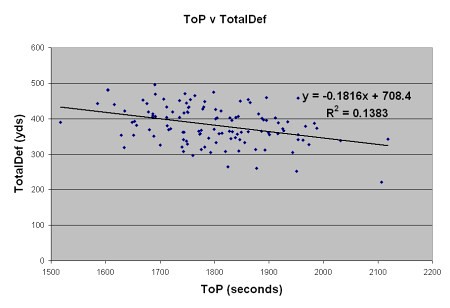
R-squared is 0.14 - still not really significant.
“Fine,” I said, “maybe I should look at Time of Possession versus Scoring Defense - because that’s what really counts. An offense that can control the ball can help protect its defense, and keep the score down."
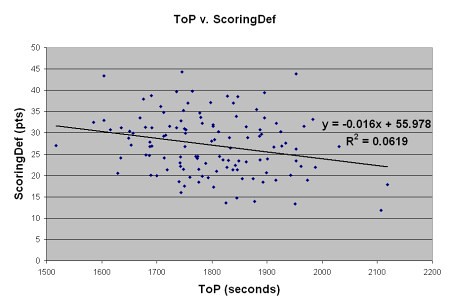
R-squared is 0.06 - not significant.
Finally, I reached back into one of the motivations for looking at this question to begin with. Why would anyone talk about Time of Possession on offense as if it were an important factor on defense, especially with respect to Michigan? Could it be because Stanford leads the country in Time of Possession, and one might try to argue that a CC that shifts the offensive philosophy towards a more ball-control, time-of-possession system would be a good way to help Michigan’s defense?
So what if we looked at the Change in Time of Possession from last year to this year, and compared it to the Change in Total Defense (least insignificant result from above)?
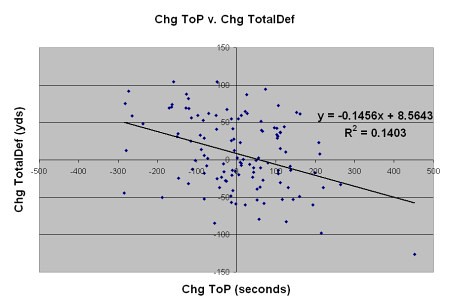
R-squared is 0.14 - still not really significant.
What this says to me is that there are too many variables that influence how a defense performs; one cannot boil it down to a simple thing like Time of Possession (or experience on a depth chart, for that matter). All of those factors may play a part, but no one individual factor is significantly correlated to a team’s performance on defense. Football is just too complex to boil down into simplistic truisms.
***** ADDENDUM *****
A related question has been raised - whether there is a link between the number of possessions and the performance of the defense. I used cfbstats.com to add up the number of 4th down conversion attempts, punts, passing TDs, rushing TDs, FG attempts, Interceptions thrown, and Fumbles lost to calculate the total number of offensive possessions (this may exclude offensive possessions at the end of each half where time simply runs out, and does not differentiate between an offense trying to score v. trying to run out the clock).
Looking at Offensive Possessions versus Defensive FEI:
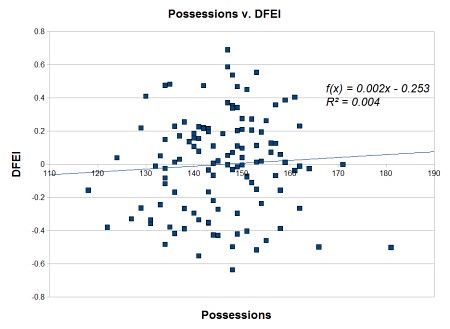
R-squared is 0.004 - not significant.
What about Offensive Possessions versus Total Defense?
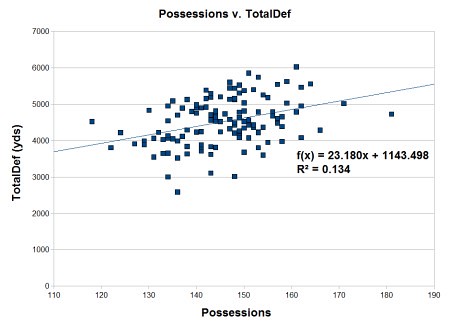
R-squared is 0.13 - still not really significant.
Finally, what about Offensive Possessions versus Scoring Defense?
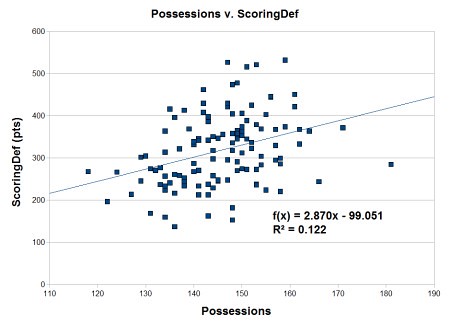
R-squared is 0.12 - again, still not really significant.
Obviously, if the underlying parameters of a model do not show correlation, one should not expect a calculated value based on those parameters to show a correlation. Nevertheless, for the sake of completion, here is the Average Time per Possession versus Total Defense:
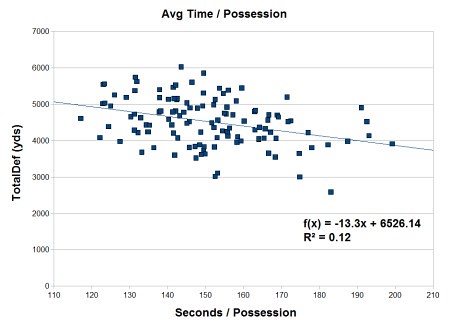
R-squared, as expected, is still only 0.12 - not really significant.
I'm afraid even looking at number of possessions rather than simply time of possession doesn't change the analysis. This suggests to me that the style of offense does not have a significant impact on the performance of the defense.
Comments